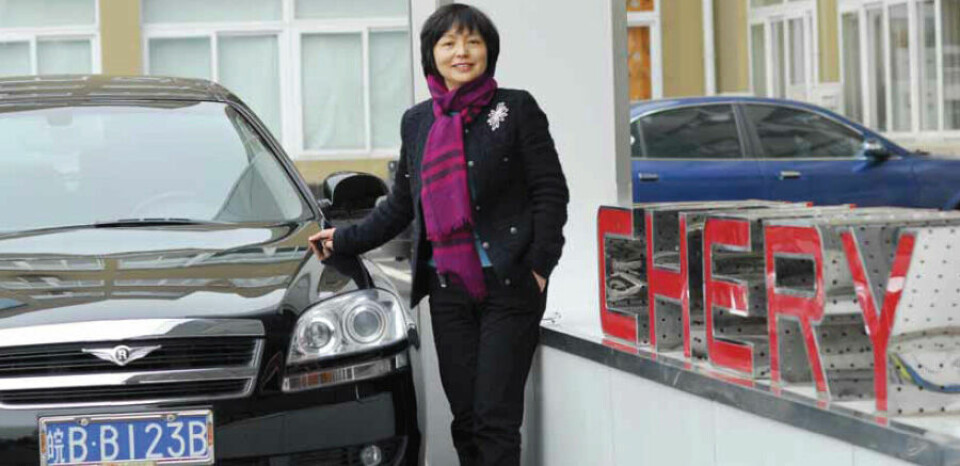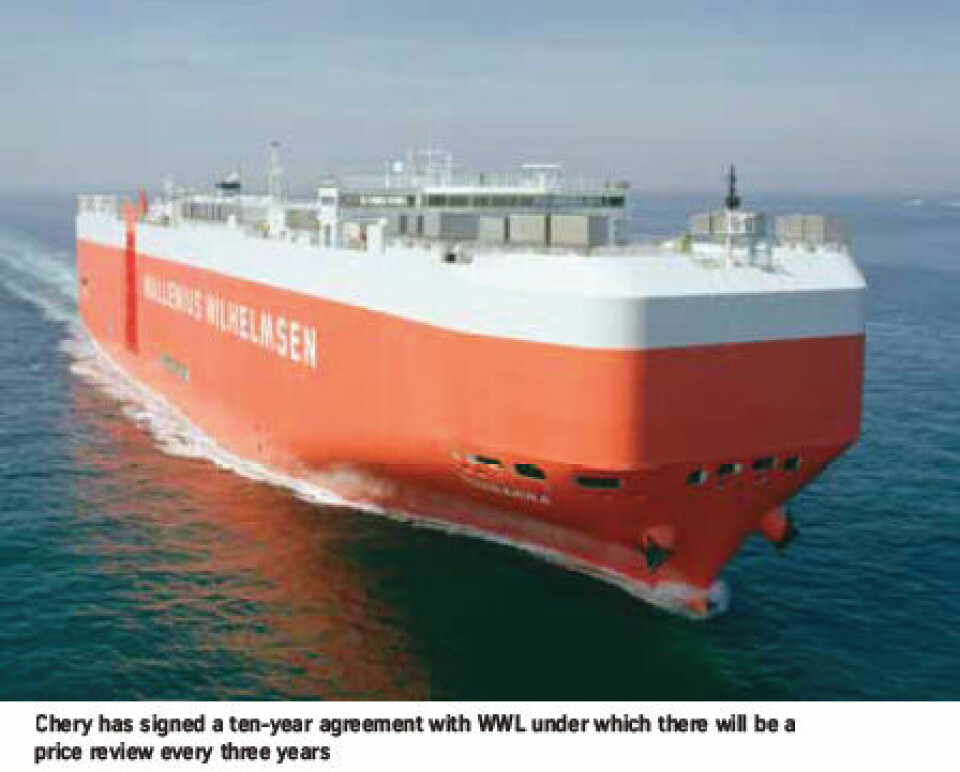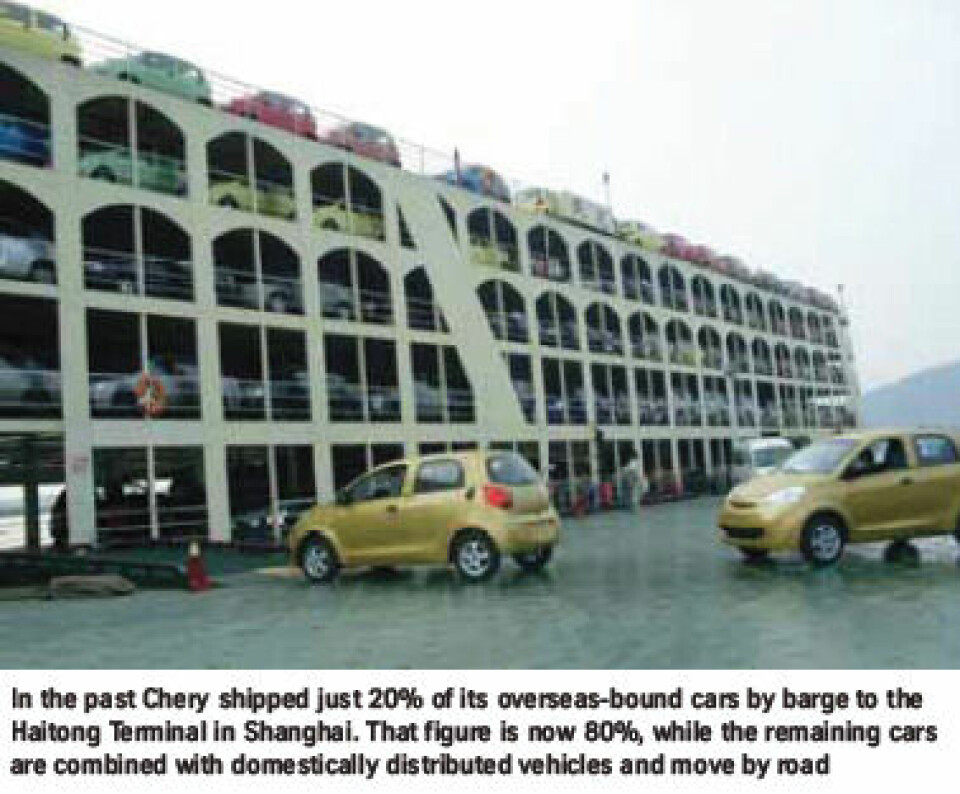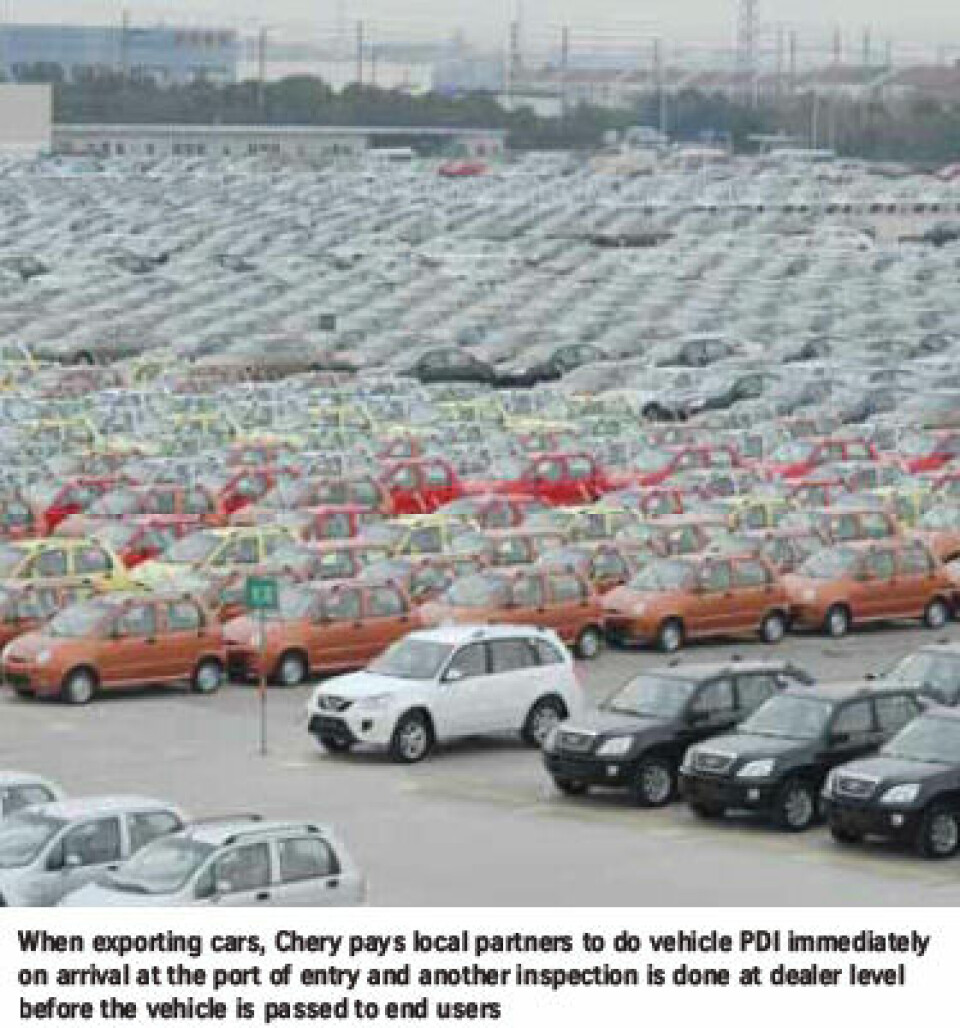Going for growth at Chery

As China’s leading automotive exporter shifts its focus toward higher-range models, Ellen Hua talks to Chery International vice-president Feng Ping about what the company expects from its logistics partners now and in the future
In 2011, the exports of Chery Automobile hit a record high of 160,268 finished vehicles and knockdown kits, representing a 33% share of China’s total car export volume. The largest independent Chinese carmaker, Chery is also the leading car exporter in China and the first in the country to sell vehicles overseas. Although China’s auto industry has grown tremendously since Chery’s first vehicle came off the assembly line at the end of 1999–the brand is now ranked seventh in China–the manufacturer’s export growth story has been an impressive one, considering that in 2005 it shipped only 10,000 units.
In its early days, Chery was less selective about export destinations, sending cars to many small markets. Nowadays, the carmaker has a much more focused strategy, including a shortlist of countries that make up its primary growth targets, largely in Eastern Europe and South America, with key export countries including Ukraine, Russia, Brazil, Chile, Venezuela, Columbia and Uruguay.
In China, besides its production base for passenger cars at Chery’s headquarters in Wuhu, 350km west of Shanghai, the carmaker is building plants in Dalian, Liaoning province and Ordos city in Inner Mongolia (a region bordering Mongolia but part of China), and has completed a new plant in Kaifeng, Henan province. There is also a factory in Guiyang intended for commercial vehicles.
Outside China, Chery has 16 knockdown (KD) assembly operations in the form of joint ventures or partnerships. Construction on a plant in Brazil also began this year. According to Feng Ping, vice-president of Chery International in charge of international operations, there was a time in the not-so-distant past that Chery, like its domestic peers, lacked shipping capacity for exports, particularly for ro-ro services. This has become a thing of the past, she says, thanks in part to China’s increasing car import and export activities. In its global expansion, while riding the wave of the overall affluence of shipping resources, the company also looked to many of its own international logistics solutions to ensure a smooth flow of vehicles to targeted destinations. Of Chery’s 2011 exports, finished vehicles accounted for around 59% and knockdown kits the remaining 41%. Most Chery exports leave the Shanghai Haitong International Automotive Terminal at the port of Shanghai, with no more than a combined 5% sent from Tianjin and Lianyungang. In future, Dalian port will be included for use after production starts there, says Feng. About 95% of Chery finished vehicles are shipped in ro-ro vessels. The rest are sent in containers, which includes a small number of prototypes or vehicles to destinations where there are fewer ro-ro services.When it first started exporting, however, Chery delivered vehicles in containers using drive-on ramps, especially as container shipping was priced relatively low and ro-ro facilities in China were inadequate to meet export needs. But there were serious limits to the container method, points out Feng.
Despite careful handling, scratches were nearly inevitable because of the narrow clearance. Starting in 2006, Chery began gradually shifting to ro-ro as its exports grew. “With car import and export increasing in the country, more and more shipping lines serving worldwide destinations call at Chinese ports–this provided a solution to the shortage of ro-ro spaces and saved worries over the limited number of destinations served,” says Feng. Chery’s ro-ro service providers include Wallenius Wilhelmsen Logistics (WWL), Höegh Autoliners and an NYK-Cosco alliance company. But container shipping still plays an important part of Chery’s export logistics, as its knockdown kit volume is substantial. Some 1,000-2,000 TEUs are shipped monthly and managed by several major container carriers including Cosco, CMA, Maersk and Israel’s Zim Line. The top destinations for Chery’s finished vehicles are Brazil, Venezuela and Iraq, while the largest assembly for knockdown kits are in Ukraine, Iran, Egypt and Russia.

As her role also covers international sales, Feng keeps a close eye on the forecasts for Chery’s major markets in 2012. For Eastern Europe, she expects that growth in Russia will slow down following last year’s surge, unless the price of oil rises and brings more money to the oil-rich country. Social and political unrest makes Middle Eastern markets an uncertainty. “That’s true especially in Egypt, where we suffered a 40% drop last year, although the sales volume was still quite large,” she says. South America was a highlight of Chery’s 2011 exports, where total sales reached 65,000 units, with Brazil the largest market. But Feng notes that Chery was not alone in its success in the Brazilian market; nearly all Chinese carmakers did well there (See Automotive Logistics, April-June 2012, p52). “But now there is a 30% tax rise in Brazil [for imported vehicles]. That will make our prices less competitive. The Brazilian market probably will not be easy in 2012,” Feng says. On the whole, Feng sees her experience in export destinations as a fairly positive one. “We and our local partners have a good understanding of each other,” she says. Despite insufficient infrastructure in some of the destination countries, Feng points out that it has not been unsatisfactory enough to affect logistics operation and sales at dealers. On the other hand, despite a good sales record, Chery is still at the beginning or in the middle of its development in most markets–volume has not been high enough to pose a challenge to stock and delivery “so some potential [capacity] problems might remain to be seen.” Feng believes the overall shipping market will remain low and there may be a surplus of shipping capacity as more vessels come online, which will depend also on further economic fallout in the eurozone. On the other hand, some lines may cut capacity quickly, leaving shortages on particular lanes. “When the market goes low, some shipping lines may leave vessels idle and cut on shipping services on certain routes. So an occasional or regional ‘space crunch’ is a new issue and I anticipate this will go on,” she says, adding that an overall rise in shipping prices may be a trend to face.

Exporting to Russia
Besides kit assembly, finished vehicle exports have seen high growth in Russia. A wholly-owned Chery subsidiary in Moscow handles vehicle distribution across the country, according to Feng, and is directly responsible for Russian operations. Vehicles are stored at the Finnish port of Kotka after being shipped by ro-ro vessels, ready for truck shipment to dealers on directions given by the Moscow-based distributor. “We ship a portion of the vehicles straight from Kotka via the border to dealers [in closer] destinations in Russia, and another part to our VDC [vehicle distribution centre] in Moscow before they are forwarded to dealers in remote locations,” says Feng. The VDC, outsourced locally, also warehouses a small number of vehicles to be delivered on a less-than-truckload basis to dealers in the west and central part of the country. Knockdown kits to Russia are shipped via sea or, somewhat remarkably, by rail across China and Russia. Chery’s KD plant, located in Taganrog, a seaport in southwestern Russia, has a close rail link. “We also have a rail connection in Wuhu, so we send block trains right from Wuhu to Taganrog, passing through Manzhouli [China’s largest land port in Inner Mongolia],” says Feng.

The company has also attempted a rarely-practised searail combined transport, sending kits by sea to Vostochny in Russian Far East, loading a block train there and moving all the way across the country to the plant. The company’s home base of Wuhu sits on the southeastern bank of China’s Yangtze River. Chery has a ro-ro quay of its own on the river, which was built especially to accommodate its logistics capacity needs for increased car export. The RMB100m ($15.8m) investment, which went into use in 2010, is seen as one of the most state-of-the-art automotive ro-ro quays in China. Before the facility was in place, the company used trucks to transport vehicles bound for overseas destinations to Shanghai for export. “Now we ship over 80% of overseas-bound cars to Shanghai in ro-ro barges, directly joining international ro-ro vessels at Haitong terminal, while the remaining 20% move by truck. In the past, we could only do 20-30% by barge,” Feng says. “This has shortened time to Shanghai for transhipment and indeed lowered damage rates.” According to Feng, damages occurred more frequently when sending the majority of vehicles by truck, either in the course of transit or because of road accidents. The ro-ro barge also affords more room for drive-on loading, which helps to reduce damage incidents.
Managing export logistics in-house
On the whole, Chery does not use third-party logistics providers to manage its exports, but negotiates and arranges contracts with the shipping lines directly. “Where there is the involvement of third parties, it is freight forwarders helping to process documents and clear customs,” Feng confirms. As is the case with other state-owned companies in China, Chery uses an in-house logistics division for many activities. The division manages delivery of vehicles off the assembly line from Wuhu to port terminals in Shanghai, including the arrangement of Yangtze River barge shipping. It is also responsible for the onward truck delivery of vehicles to the port and for sale in Shanghai, which are combined together. The logistics division is referred to internally as a company, however it is not a registered legal entity and serves Chery exclusively. As it relies on outsourced transport, it acts more like the logistics arm of the OEM than it does an LSP. It works only in the outbound side. Independent management often stops at the ports of exit. “Upon arrival at destinations like Russia, we outsource trucking services to local logistics companies, ”says Feng. According to a source from Feng’s team, Chery uses thirdparty logistics services only for inbound logistics.
Long-term partnerships with shipping lines
Feng believes that Chery has maintained a good relationship with its shipping lines. “For 2011, we are generally satisfied with our service providers, whether in terms of shipping cost or space availability,” says Feng. “Even if there have been space shortages occasionally for certain destinations, we eventually managed,” she adds. Feng attributed such success to Chery maintaining longterm, win-win partnerships in international logistics. The company signs multi-year agreements with shipping lines, with prices adjusted regularly according to the framework of the contract. The common process for winning contracts is still primarily through bidding, as neither party is usually willing to fix a price, given market fluctuations. “But bidding is based on long-term considerations from both sides,” she says. “Under our agreement, a precondition to winning a contract is that you should not quote us above-market prices. On the other hand, we do not invite shipping lines to join bids for each shipment–we vary it regularly and by routes.” With WWL for example, the carmaker has signed a ten-year agreement and within that period a price review is done every three years. “The long-term agreement defines our relationship as a strategic one, so it brings mutual trust. Even when business is not there, a sort of business rapport is there. If you are shortsighted, so the other side will be too,” says Feng. However, Feng notes that the multi-year agreement does not necessarily keep providers from offering new or alternative services. “Each shipping company has its own strength. They are sure to come to bid for our business if they find their offer for a certain route is especially competitive.” she says.
Focus on efficiency rather than price alone
For Feng, carmakers have to work hard to control costs, especially given a carmaker such as Chery’s focus on economic products. While logistics is an important part of a vehicle’s cost structure, Feng acknowledges that logistics performance is also critical to a carmaker’s success and that there is only so much that can be achieved by negotiating down shipping prices alone. “Logistics targets and tasks are set out each year and cost is often a pressure. I think we did a good job in 2011 about that cost, but it was still a big challenge for us, even though the cost was low relative to the previous years,” says Feng. “But I would also like to look at many options other than cutting shipping cost. For us, without doubt, the lower the shipping cost the better, but it’s hard to bring it down when it’s already at a low level.” Feng says that supply chain management is an important way to keep logistics costs down, including streamlining the export process and improving order-to-delivery cycles. “There is a lot that can be done–better inventory rotation, an increased accuracy rate for planning, speeding up of the delivery process to Shanghai port, shortened waiting times in terminals, etc,” says Feng. “It all leads to a shorter order-todelivery time. Less time on logistic processes means a more efficient use of capital. So we also work on our supply chain management to cope with the cost challenge.”

Investing in improved logistics
Like other OEMs, Feng says that logistics is a non-core part of Chery, yet there are considerable efforts made to improve logistics performance. Chery has invested in developing its own DMS (dealer management system), which covers logistics management and contributes to IT visibility. Apart from IT investment in the right systems, the carmaker has also worked to improve logistics capabilities in other areas. When exporting its vehicles, Chery carries out PDI (pre-delivery inspection) at two levels in many destination countries. “We pay local partners to do vehicle PDI immediately on arrival at the port of entry. Another PDI is done at dealer level before passing vehicles to end users,” Feng says. Sometimes, operational challenges in logistics have also driven technological changes in the products themselves. For example, Chery’s early exports were not engineered for long journeys at sea. In some cases, a month or longer sailing time led to electricity wastages in the vehicle that could make it more difficult to start upon arriving at the destination. Today, Chery vehicles now have a power-saving application that can be set to ‘long-distance transport mode’ while vehicles are at sea. “We have now developed this power-saving mode for all types of cars for export,” Feng says. In KD kit exports, packing and packaging is a challenging area that Feng wants to address with a more optimised packaging solution. “Packaging design is related to damage rates, which is an important focus, but [good design] also means more efficient use of container space, which is important to lowering cost.”
Chery develops its own packaging solutions and has an export packaging centre to serve the purpose of stuffing the kits into containers. Feng admits that some external providers have approached the company about the possibility of introducing the use of their packaging services and products. “They do have experience to offer, but their products do not necessarily fit us best. Our own design fits us better because we know our own car models better. We touch those kits every day. Plus, as we have a variety of car models, it just confuses them more,” she comments.
Time of transition
As Chery cars are sold mainly in the low-to-middle range, logistics is important for delivery at high speed and at a large scale. But as the brand focuses on higher-range, more innovative models, Feng says there will be increased requirements for logistics. From a marketing perspective, this transition is likely to be slow and difficult in the first place. “Lifting a brand to a higher level involves more inputs in products and branding. It takes time to make people aware of our transition and establish word-of-mouth success, ” says Feng, picking up a book on automotive marketing called Satisfaction: How Every Great Company Listens to the Voice of Customers (by JD Power and Associates). She adds that the success story of South Korean’s Hyundai is an inspiration to Chery. The Hyundai example also demonstrates how fast and efficient logistics plays a role as a carmaker moves to a higher level in consumer perception, as expectations for delivery times and services are correspondingly higher. “Shifting to more focus on middle-end vehicles means there is much more extra work [expected] from us. And as a result this also means there will be stricter requirements set out for logistics operations, like lower damage rates and more demanding KPI targets,” says Feng. So, as Chery expands its exports, targets new markets and looks to go upmarket, there is no question that the expectations will also be raised for its logistics providers.





